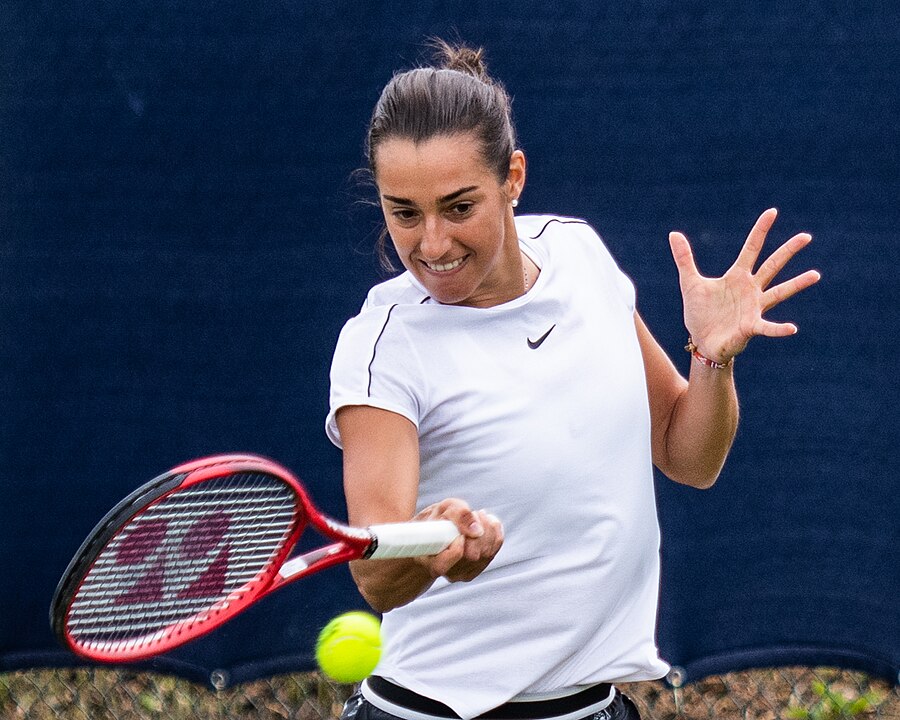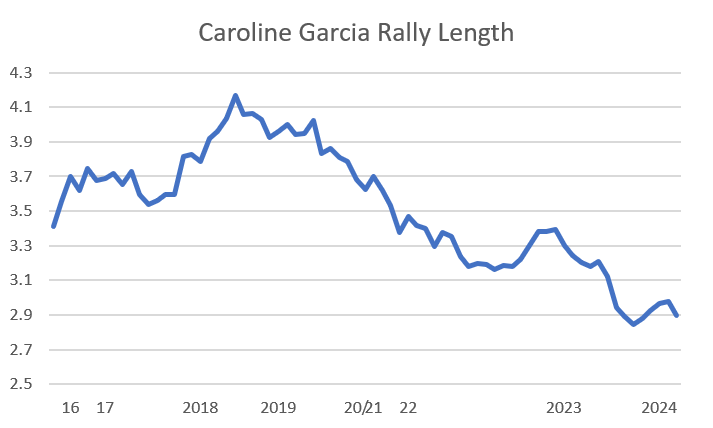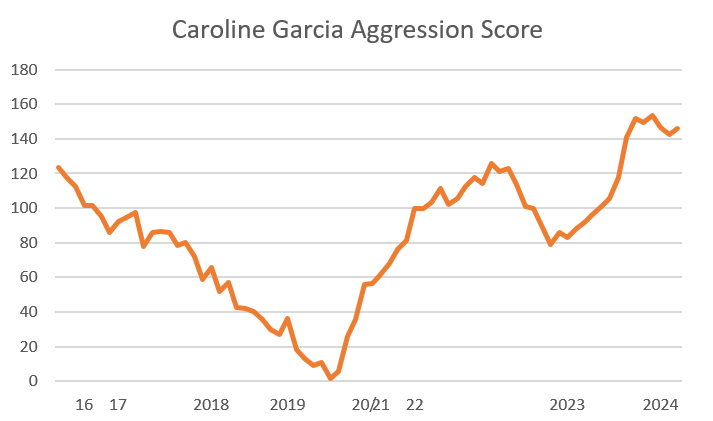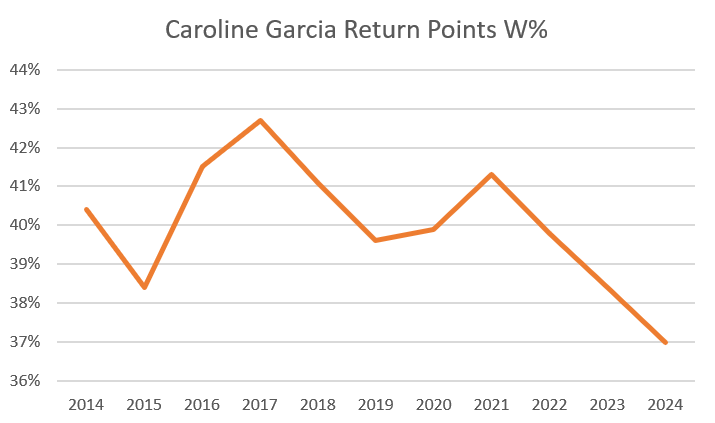
Last night, Caroline Garcia scored what many fans saw as an upset, straight-setting two-time Australian Open champion Naomi Osaka. While Garcia was seeded 16th and Osaka is just beginning a comeback, no one ever knows quite what to expect when the Frenchwoman takes the court. The former champ, for her part, has always been at her best on big stages.
The result was almost pedestrian. Garcia turned in a performance that exemplified the tennis of her late 20s: Serving big, returning pugnaciously, taking risks, and–on the rare occasions that Osaka left her an opening–net rushing. Osaka served well, but the 16th seed out-aced her, 13 to 11. More than three-quarters of points were decided in three shots or less, and Garcia stole a few more of those from her opponent than Osaka did from her. In a contest defined by small margins–one break of serve and a tiebreak–that was all it took.
The strange thing is, Caro didn’t use to play like this. She plays shorter points than any other tour regular, an average of 2.9 shots per point in charted matches from the last 52 weeks. It isn’t just about her powerful first serve: Her return points end even sooner than her serve points do. Back in 2018, when she first reached her career-best ranking of 4th on the WTA computer, she was averaging over four shots per point, a rally length that would put her in the range of Jessica Pegula and Maria Sakkari: in other words, a very different sort of player.
Here is the evolution of Garcia’s rally length, shown as a rolling 10-match average, for the 84 matches in the charting dataset:
Last night’s rally length was a blink-and-you’ll-miss-it 2.5 shots, the second-lowest figure I have on record for Garcia. Only a match against Donna Vekic last year comes in slightly lower, though last week’s match in Adelaide against Jelena Ostapenko may have been even more extreme. Osaka’s big game helped keep the number down, but it takes two to so comprehensively avoid the long-rally tango.
Garcia’s first serve has always been a weapon. But her tactical approach behind it has fluctuated wildly. The career trend of her Aggression Score in rallies illustrates how she has careened from one extreme to another. Aggression Score is scaled so that the most passive players rate around -100 and the most aggressive around 100, though Ostapenko and others have pushed the maximum figures further into triple digits. Here is how Garcia’s score has changed over time, again as rolling ten-match averages:
I don’t think there any other player in tennis–man or woman, past or present–who has followed a path like this. As she established herself as an elite on tour, even as she rose into the top five, she became more and more conservative. For reference, players who posted scores around zero in 2023 were Sakkari and Martina Trevisan, hardly styles that will remind you of Garcia’s. Eventually she reversed course, not only regaining her former style but surpassing it, ranking among Liudmila Samsonova and Aryna Sabalenka as one of the most aggressive players on tour, a rung below the class-of-her-own Ostapenko.
Is it working?
The oddest thing about the multiple phases of Garcia’s career is that she has reached the No. 4 ranking with two different styles. In each of her first three charted matches after achieving the peak ranking in 2018, she posted negative rally aggression scores. In two matches against Sabalenka, she averaged 3.9 and 3.7 shots per point; against Karolina Pliskova in the Tianjin final, the typical point lasted 4.3 strokes. When she returned to the No. 4 ranking at the end of 2022, after years in the wilderness, she was frequently posting triple-digit aggression scores and average rally lengths below 3.
The main effect of Garcia’s current style is that it makes the most of her serve. From 2015 to 2017, she won just over 66% of her first-serve points, a mark that is good but sub-elite. She fell all the way to 62% in 2021 before the big shift; since then, she has won more than 70% of her first-serve points. She ranked fourth in that stat heading into the Australian Open, and she converted nearly 90% of her first serves against Osaka. Her success behind the second serve hasn’t shown the same improvement, but the overall picture is a good one: She won more total serve points in 2023 than ever before.
The return game is a different story. This is where even a casual viewer can’t miss Caro’s new tactics: She’s not afraid to stand well inside the baseline to return serve, and yesterday she net-rushed one Osaka serve, SABR-style. Measured by court position, if not by winners and error stats, Garcia is even more aggressive than Ostapenko.
At her best, the Frenchwoman posted acceptable return numbers, if not great ones. Her best single-season mark, winning 42.7% of her return points in 2017, put her in the bottom third of top-50 players. As she has upped the intensity of her attack, this key number has headed south:
In the last 52 weeks, she has won just 38.3% of return points, worst among the top 50 by two full percentage points. Among the top 20, no one else is below 42%. She can get away with it because her own serve is so rarely broken, but such ineffectual return results will make it difficult to mount another assault on the top five. Breaking serve so rarely dooms her to a career of three-setters and narrow decisions. Those sorts of results can sometimes be encouraging–as in her pair of recent three-set losses to Iga Swiatek–but have a knack for halting winning streaks, too.
It doesn’t have to be this way. Players don’t sign contracts agreeing to deploy the same tactics on both sides of the ball. Garcia won return games far more often in her less aggressive days, breaking 33% of the time in 2017 compared to a dreadful 23% last year.
Some of Caro’s 2017 skills are still in evidence. She is solid enough in long rallies that she doesn’t need to so actively avoid them: In the last year, she has won a respectable 48% of points that lasted seven or more strokes, and if you remove the two Swiatek matches, she breaks even. While the Osaka match was primarily determined by short points, Garcia won 17 of 29 (59%) that went to a fourth shot.
Without any major changes, Garcia will remain the sort of player who aggravates fans and opponents alike, a dangerous lurker capable of delivering upsets, inexplicable marathons, and lame early exits in equal measure. Like any hyper-aggressive player, Caro’s results can be seemingly random, with all the frustration that entails. Unlike Ostapenko, Sabalenka, and the many ball-bashers on tour, though, Garcia has chosen to play this way, rebuilding her game into something that the 2018 version of herself would hardly recognize. If she can somehow join her late-career serve to her earlier return-game tactics, the randomness will disappear, and Caro may make yet another appearance in the top five.
* *
Subscribe to the blog to receive each new post by email:



In 2023 Garcia had break point in 35.7% of her return games. 5th lowest among players with at least 150 return games played.
116. Caroline Garcia 35.7%
117. Rebecca Marino 35.7%
118. Alycia Parks 35.5%
119. Shuai Zhang 34.8%
120. Dalma Galfi 33.9%
At the top are players who actually put the ball in play…